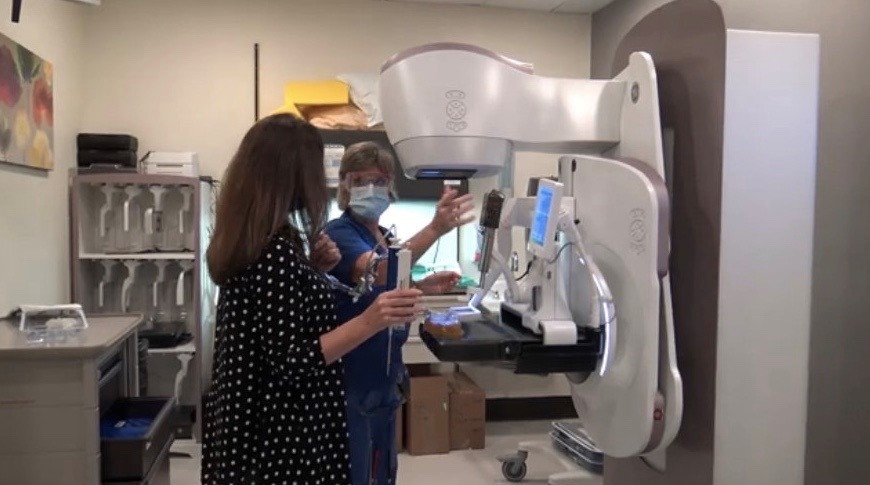Lawson first in North America to study new biopsy method for breast cancer patients
 (Source: Lawson Health Research Institute)
(Source: Lawson Health Research Institute)
Researchers at the Lawson Health Research Institute have piloted a new technique that will make breast cancer biopsies easier for patients, a new study found.
Radiologists at Lawson found a new form of mammography software that combines contrast enhanced mammography (CEM) with mammography guided biopsy technology at St. Joseph’s Health Care.
According to Lawson Associate Scientist and Breast Radiologist at St. Joseph’s, Dr. Anat Kornecki, this will make the procedure more accurate and easier for patients and technicians.
Lawson is the first place in North America to offer this procedure to patients through the St. Josephs Brest Care Program.
Two other centres in Europe were the first to use this technique which has been cleared by Health Canada and the U.S. Food and Drug Administration.
Researchers say CEM is a new form of mammography that uses contrast iodine which helps radiologists see potential cancerous lesions. If a lesion is found then a biopsy can be performed.
“If a lesion is detected only by CEM we usually offer an MRI guided biopsy, but we first need to find the same lesion on an MRI,” said Kornecki.
Before this new method, technicians were only able to detect potential lesions on contrast enhanced mammography and were biopsied under MRI, which often takes longer since MRI availability is limited.
“The problem is that it is sometimes hard to find the same lesion and the MRI itself can be uncomfortable for the patient. Also, some lesions that are close to implants or chest walls cannot be reached with MRI guided biopsy,” Kornecki added.
In a study including 50 patients, researchers found 51 potentially cancerous breast lesions, leading to 46 biopsies.
The results showed 11 had breast cancer, 10 were considered high-risk lesions, and the remaining lesions were benign.
“These are very similar results that were reported through MRI-guided biopsies, which means that this new method can replace the MRI,” Kornecki explained.
CTVNews.ca Top Stories

Five years after toddler's brutal death, Northern Ont. family struggles to find peace, justice
A North Bay family is struggling to find peace and justice as the five-year anniversary of the brutal death of toddler Oliver McCarthy approaches.
Alberta RCMP officer charged with 2 counts of sexual assault
Const. Bridget Morla, a Leduc RCMP officer, has been charged with two counts of sexual assault in connection with an incident that happened two years ago.
Ontario dad removes hockey rink at heart of neighbour dispute
A Markham dad who drew the ire of neighbours and the city after installing a hockey rink in his backyard says the rink has now been taken down.
Kingston, Ont. doctor in 'disbelief' after being ordered to repay $600K for pandemic vaccination payments
An Ontario health tribunal has ordered a Kingston, Ont. doctor to repay over $600,000 to the Ontario government for improperly billing thousands of COVID-19 vaccinations at the height of the pandemic.
Three climbers from the U.S. and Canada are missing on New Zealand's highest peak
Three mountain climbers from the U.S. and Canada are missing after they failed to return from a planned ascent of New Zealand's highest peak, Aoraki, authorities said Tuesday.
Motivated by obsession: Canadians accused in botched California murder plot in police custody
Two Canadians are in police custody in Monterey County, California, after a triple stabbing police say was motivated by a B.C. man's obsession with a woman he played video games with online.
Trump demands immediate release of Oct. 7 hostages, says otherwise there will be 'HELL TO PAY'
President-elect Donald Trump is demanding the immediate release of the Israeli hostages still being held in Gaza, saying that if they are not freed before he is sworn into office there will be “HELL TO PAY."
Belly fat linked to signs of Alzheimer’s 20 years before symptoms begin, study says
As the size of a person’s belly grows, the memory centre of their brain shrinks and beta amyloid and tau may appear — all of this occurring as early as a person’s 40s and 50s, well before any cognitive decline is apparent, according to new research.
More RCMP and CBSA ‘human resources’ destined for border, Public Safety Minister LeBlanc says
Public Safety Minister Dominic LeBlanc says the federal government will 'absolutely' be adding more Canadian Border Services Agency (CBSA) and RCMP ‘human resources’ at the border.

































